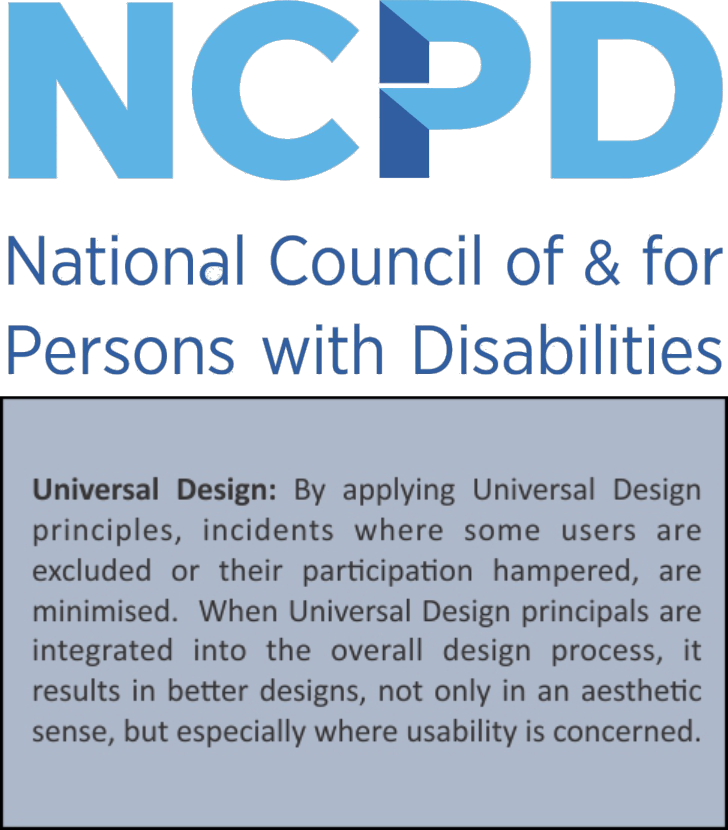Accessible Routes
Contents: To jump to the topic you would like, click on the links below
Introduction
An important part of accessibility is not only accessible parking spaces, passenger loading zones, ramps, Disabled Toilets & Lifts, etc but also insuring that there are various accessible routes from the public streets onto the pavements & to the accessible building entrance and to the facilities inside the building & visa versa. Appropriate accessible routes should also be made available for emergency exits. Accessible Routes include:
- Ramps on & off the pavement
- Wide enough walkways for a variety of size wheelchairs
- No obstacles on these pathways
- Wide doorways & turning areas, etc
The South African National Standard for Building Regulations
The South African Government through The South African National Standard for Building Regulations passes laws that insure that new buildings & structures are designed & build with a certain regulations, which includes regulations on Accessible Routes.
There must be a means of access that is suitable for people with disabilities to use. In addition, access must be available from various approaches of the building via the main entrance and any secondary entrances, and should lead to the ground floor.
There must be a means of egress (a point of departure) that is suitable for people with disabilities to use in the event of any sort of emergency. This relates to any sort of emergency, but in addition, a further clause states that departure routes (or egress) must also be designed in accordance with Part T of the regulations, namely the section that relates to Fire Protection.
Unfortunately many buildings in South Africa were not designed and built to accommodate wheelchair users or the elderly. The owners of these buildings may therefore be challenged by the need to find architects and renovators familiar with accessible design issues in order to make them accessible. There are however various Organizations and Companies that can assist with Universal Design and Access to make sure that persons with disabilities are not excluded from any events, services, information, communication, products and venues.
Organizations & Companies That Can Assist With Universal Design & Access
There are now various Organizations and Companies that specialize in Universal Design and Access and can advise you on how to adapt these Accessible Routes to make sure that persons with disabilities have equal rights and no loss of dignity. The National Council of and for Persons with Disabilities (NCPD), Bradshaw LeRoux Consulting, The QuadPara Association of South Africa (QASA) and DiSA specialize in Universal Design and Access to make sure that persons with disabilities are not excluded from any events, services, information, communication, products and venues. These Organizations and Companies can assist in different ways including:
The National Council of and for Persons with Disabilities (NCPD): believe that this can be prevented by applying Universal Design Principals during the design phase and they therefor offer the following services to assist:
- Workshops for architects, developers and other building professionals to develop an understanding of universal design and access.
- Facilitating access audits for new or existing buildings; echo e-access for the natural and communication environment. Audits are followed by a report indicating shortfalls and recommendations.
- Marketing of facilities that are accessible to persons with disabilities
Contact Fanie Swanepoel or Danie Marais for more information on Tel: +27 11 452 2774 or email them on: fanies@ncpd.org.za or danie@ncpd.org.za
QASA: The QuadPara Association of South Africa (QASA) is a non-profit organisation (NPO 000-881) of Quadriplegics and Paraplegics in South Africa. QASA’s mission is “to improve lives by securing resources to advocate, educate, capacitate, support and mobilize”. QASA’s vision is that “all quadriplegics and paraplegics will live their lives to their full potential”. QASA develops products, programmes and services for quadriplegic and paraplegic members to build their capacity and ensure opportunities for societal integration and empowerment.
will live their lives to their full potential”. QASA develops products, programmes and services for quadriplegic and paraplegic members to build their capacity and ensure opportunities for societal integration and empowerment.
These Services include but are not limited to Access Audits:
An access audit is a form of inspection that can be used to assess the ease of access to, and ease of use of an environment (such as a building or landscape), a service, or a facility, by people with a range of access impairments.
Everyone has the right to be able to fully participate within society, and the built environment and accessibility plays a vital role in achieving this goal. Persons with mobility impairments are faced with physical barriers that exclude them from societal integration, be that in the workplace, educational & recreational facilities.
Bearing this in mind it is of utmost importance that we make our spaces accessible, it is not only an issue of equality and justice, but it makes good business sense, and adds to contributing to the development of a more inclusive and equal society.
Access Audits identify features including:
- The current accessibility of the building
- Areas for improvement (e.g. no accessible parking in the car park or the door in the accessible toilet on the ground floor is incorrectly located and therefore the building is inaccessible)
- Good/bad practice in relation to facilities management that an organisation has in place; positive accessibility features (e.g. counter tops at reception, good use of lighting and colour throughout building, signages)
Benefits of Accessible Environment:
- Increases the pool of potential new employees that an employer can tap into
- Retain existing employees who may acquire a disability through an accident / medical condition
- Enables more persons with disabilities to enter the building and /or use the services
- Improves overall safety of buildings, which has a direct impact on the number of accidents taking place and therefore the cost of insurance premiums.
Click on the link above to find out more about "Access Audits", or visit our Organizations - QASA Page to find out more about QASA and the other Projects and Services that they provide, or their website at www.qasa.co.za.
These Organizations and Companies listed above which specialize in Universal Design and Access will follow those standards set by "The National Building Regulations and Building Standards Act" to make sure that persons with disabilities are not excluded from any events, services, information, communication, products and venues.
Regulations for Accessible Routes & Doorways
4.4 External and internal circulation
4.4.1 General
4.4.1.1 An accessible route shall form part of an external and internal circulation route.
NOTE: The space allowances of this part of SANS 10400 should accommodate the use of self-propelled wheelchairs. The minimum dimensions might need to be increased to accommodate the full range of different types of wheelchair.
4.4.1.2 At least one accessible route shall be provided within the boundary of the site from all public transportation stops, accessible parking spaces, passenger loading zones and public streets and pavements to the accessible building entrance which they serve and the facilities inside the building.
4.4.1.3 There shall be a means of access suitable for use by persons with disabilities from the outside of the building to the ground storey.
4.4.1.4 The clear width of the walking surfaces shall not be less than 900 mm (such as between bollards in parking areas, or between planters and seating) and shall not be reduced by protruding objects. If the clear width is less than 1,5 m, an accessible route shall be provided with passing spaces of 1,5 m × 1,5 m (minimum) at intervals not exceeding 5,0 m, or an intersection of two walking surfaces which provide a T-shaped space.
4.4.1.5 Each accessible entrance to a building shall have at least one door or doorway in accordance with the requirements of 4.6.1.
4.4.1.6 Revolving doors, revolving gates and turnstiles shall not form part of an accessible route.
4.4.1.7 Pause areas, with suitable seating, shall be provided adjacent to an accessible route at intervals that do not exceed 25 m.
4.4.2 Turning spaces
4.4.2.1 The turning space allowance, e.g. for a wheelchair, guide dog or person on crutches, shall be a minimum of 1,5 m in diameter, inclusive of any toe and knee clearances.
4.4.2.2 Doors shall not be permitted to swing into the turning spaces.
4.4.3 Obstructions in the path of travel
4.4.3.1 Protruding objects shall not reduce the clear width required for accessible routes.
4.4.3.2 Hanging signs, lights, awnings and objects that protrude into circulation spaces shall have a clearance of at least 2 m above the trafficable surface.
4.4.3.3 Windows and doors shall not open across a walkway, corridor, stair or ramp. Doorstops shall be so positioned that any door will open to its maximum, and that they will not create a hazard.
4.4.3.4 Wall-mounted fire extinguishers, hose reels, telephones, litter bins and any other wall-mounted fittings shall
- be designed to be easily seen,
- be shielded or recessed to prevent injuries, and
- be accompanied by a feature that warns of the presence of the potential hazard and that is possible to detect by a person using a white cane or stick.
4.4.3.5 A dished channel shall not be constructed within the boundaries of a path.
4.4.3.6 A drainage grating that is within the boundaries of a path shall be set flush with the surface of the path. Such grating shall be placed so that its longitudinal elements are perpendicular to the main walking direction, and the gap between them shall not exceed 13 mm.
4.4.3.7 Where identified parking for persons with disabilities is provided, a kerb cut that has a slip-resistant finish and gradient that does not exceed 1:12 shall be provided immediately adjacent to the bay (see figure 3).
NOTE 1 Kerb cuts should be provided where required, and in conjunction with pedestrian crossings, taxi and bus ranks and parking garages.
NOTE 2 The recommended surface between a pavement and roadway is a ramp fitted with tactile guidance surface indicators. This provides a safe and trafficable surface for wheelchair users, and a detectable surface to indicate to persons with visual impairments that they are leaving a pedestrian footpath and entering a traffic roadway.
4.5 Floor or ground surfaces
4.5.1 Floor and ground surfaces form an integral part of the accessible route throughout the site, both internally and externally, as part of the continuous path of travel. They shall be stable, firm and slip resistant (see SANS 784), under wet and dry conditions.
4.5.2 Carpet, carpet tiles or other floor finishes shall be securely attached and level across all types of pile. Pile height of carpets shall not exceed 3 mm.
4.5.3 Openings in the floor finish or ground surface shall not exceed 13 mm in diameter and, where the opening is elongated, the long dimension shall be placed perpendicular to the dominant direction of travel.
4.5.4 The vertical change in level between two floor surfaces, or at thresholds, shall have a flush finish and shall not exceed 5 mm in height.
4.5.5 Where a surface is cambered for drainage purposes, the camber shall not exceed 1:50 (see figure 4).
4.5.6 Cobbles (whether fixed or loose), gravel sand and other raised or loose finishes shall not form part of an accessible route.
4.6 Doorways, doors and door handles
4.6.1 Doorways and doors
4.6.1.1 Doorways shall allow free access for wheelchair users. The clear opening shall be at least 750 mm when approached along a line that is perpendicular to the opening, as shown in figure 5.
NOTE It is recommended that, where possible, the clear opening width should be 800 mm.
4.6.1.2 Where a two-leaf door is used, the clear opening provided by the leading leaf shall be at least 750 mm, as shown in figure 6, when approached along a line perpendicular to the opening.
4.6.1.3 Minimum access dimensions to enable wheelchair users to make 90° turns, shall be as shown in figure 7.
4.6.1.4 Where a person in a wheelchair is required to open a door towards the wheelchair, a nib of at least 450 mm shall be provided at the handle side of the door, as shown in figure 8.
4.6.1.5 The minimum distance between doors shall be as shown in figures 9 and 10.
4.6.1.6 Sliding doors may be installed in places where a hinged door would hinder circulation or manoeuvrability.
4.6.1.7 Where revolving doors, turnstiles or other barriers are installed, an alternative means of access shall be installed.
NOTE 1: Doors are a hindrance and their use should be avoided. Where doors cannot be avoided, for example, in a route used for emergency egress, doors should be held open by a mechanism that is safe, comfortable and convenient for persons with disabilities to operate, such as magnetic closers.
NOTE 2: Frequently used doors, such as main entrance self-closing doors, should preferably open automatically and be equipped with a fail-safe system that enables the door to open under emergency conditions
4.6.2 Door handles
4.6.2.1 A handle fitted to a door leaf of a door in an emergency route or in a feeder route or in any compartment containing toilet facilities for use by persons with disabilities, shall be of the lever type, with a lever at least 150 mm long, and shall be installed at a height that does not exceed 1,0 m above floor level.
4.6.2.2 Round door knobs do not provide an adequate grip for persons with impaired dexterity and shall be avoided.
4.6.2.3 All doors shall be openable with one hand.
4.6.2.4 All door handles shall be horizontally aligned.
4.6.2.5 Door furniture with sharp protruding edges is hazardous and shall not be used.
4.7 Changes in level
4.7.1 In trafficable areas for public use, any changes in level shall comply with the requirements of SANS 10400-D, and with the requirements given in 4.7.2 and 4.7.3.
4.7.2 A raised kerb, not less than 75 mm high, or a skirting rail not more than 300 mm high, measured vertically above the surface, shall be provided on exposed sides of any ramp, stairway, balcony or any similar area where a change in level occurs.
4.7.3 Where a change in level of more than 600 mm occurs, a handrail shall also be provided.
Links
- Building Regulations for facilities for Disabled Pdf.
- Standard Electrical, Mechanical And Architectural Guideline For The Design Of Accessible Buildings (Facilities For Disabled Persons)
To find Companies and Organizations that can assist you, visit our "Services & Service Providers" Search Facility. If you require any Products listed on this page, visit our "Products" search facility.




